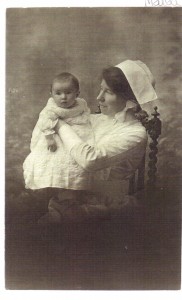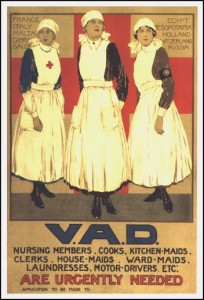 Before writing this, these are the facts I knew about my great-aunt Maud Reid: She was born in Manchester in about 1882, and before, during and after the war she was a nurse. My mother remembers her husband as ‘Uncle Willie’. Mum also remembers her as a handsome, elegant woman.
Before writing this, these are the facts I knew about my great-aunt Maud Reid: She was born in Manchester in about 1882, and before, during and after the war she was a nurse. My mother remembers her husband as ‘Uncle Willie’. Mum also remembers her as a handsome, elegant woman.
Firstly checking for a baptism record, I found that she had actually been born on 25th April 1880 and baptized on 22nd June 1881 in Collyhurst. This tells us that we should never trust the ages given in census records, and should always widen our searches for at least 2 to 5 years when looking for a specific birth record.
I then looked for her marriage. Using Ancestry.co.uk, I put her name into the search engine, the place name of Manchester, a date of 1908 with ten years either way, and the name William into the spouse’s name. No obvious results came up, so I tried spelling the name differently, and I also searched FamilySearch.org and the useful online parish clerks website for Lancashire at www.lan-opc.org.uk.
Nothing came up, so I searched for her in the 1901 and 1911 census records. In 1901 I believe I found her working as a servant (with her surname spelled ‘Reed’) in the household of a John Harrison, ‘traveller in confectionary’, the district of Chorlton. She is named as a domestic servant, but if this is her, then I suspect that she was working as a private nurse for the 2 year old Charles Harrison.
Domestic service was the most common job for single working class women before the First World War. Tough work, but it was better than working in the mills. This particular household was a small one – most people above working class status had servants at this time, often a nurse, cook or general maid.
In the 1911 she appears to be still single and still working with the Harrisons – but still as a domestic servant. If I was right about this being her, then she married quite late, as she was now 29 years old. There is also a visitor who is a nurse, but Maud is the only living-in servant.

As she was still single in 1911, I needed to search for a later marriage – and found a marriage in 1930 in Manchester to a William J OAKES. This would have made her 50 when she married. I checked this surname with my mother and, yes – she remembered, that was her name.
So Maud was single for a long time and married very late in life for those times. By her looks, I think she was strongly independent, intelligent and kind. Was she perhaps a suffragette? And what did she do during the war?
Many suffragettes either stayed away from home on the night of the 1911 census, or made a statement on the census paper itself. As a live-in servant, Maud would not have been able to do this, so we need to search other records. One of the best sources for searching anyone who took part in suffragette campaigns is the national newspaper archives. I checked the databases on FindMyPast and the British Newspaper Archive but found nothing.
She may not have been a suffragette, but we know that Maude was a woman perhaps ahead of her time – and so were some of her sisters. She also helped her youngest sister, Dorothy (who worked at Lewis’s) to organise a royal banquet; more about this when I look at Dorothy’s life.
So what did she do during WWI? FindMyPast has a database of military nurses. However, my searches produced no results. I then went to the National Archives website where you can search online for British Army nurses 1914-1918 (other nursing records are only available at Kew). The most likely records would be in the Queen Alexandra’s Imperial Military Nursing Service or the Red Cross. I tried all variations of the name but did not find anything for the nursing corps. Another useful website is the Red Cross site at: http://www.redcross.org.uk/About-us/Who-we-are/Museum-and-archives I tried a search here, but could not find a Maud Reid with any of the spelling variations.
In the TNA I did find a medal card for a Maude REID in the Queen Mary’s Auxiliary Corps Regiment, classed as ‘Worker’. I decided the £3.30 charge for downloading this record was worth it, even though I wasn’t totally sure this was her. The actual record does not tell us much so I googled for more information about the Queen Mary’s Auxiliary Corps. At www.1914-1918.net I found that this regiment was started in 1917 and made up of volunteers who worked mainly as cooks, caterers, clerks, telephonists and motor vehicle maintenance.
I don’t know whether this is my great aunt. Unfortunately, many World War I records were destroyed during World War II bombing, so it may be that Maud’s records have not survived. However, the available records show us that women were beginning to be seen as essential parts of the war effort, and despite the dreadfulness of the war, it did bring up many opportunities for young, single women such as Maud. For the first time they were involved in jobs such as vehicle maintenance and administration – previously thought of as male careers.
At home they were needed as nurses to look after the vast numbers of injured service men as they returned from the battlefields.
The Voluntary Aid Detachment (VAD) was formed in 1909 to provide nursing services in times of war. While many  women – mostly middle and upper classes – offered their services at the outbreak of World War I, the Red Cross did not want civilian women serving overseas as they were not used to the hardships of the front line. However, the records show that those who did serve on the front line acquitted themselves with great fortitude and efficiency. As nurses became more and more necessary overseas, volunteers over 23 and with more than three years of hospital experience were allowed to serve overseas. VAD hospitals also opened at home in large British towns.
women – mostly middle and upper classes – offered their services at the outbreak of World War I, the Red Cross did not want civilian women serving overseas as they were not used to the hardships of the front line. However, the records show that those who did serve on the front line acquitted themselves with great fortitude and efficiency. As nurses became more and more necessary overseas, volunteers over 23 and with more than three years of hospital experience were allowed to serve overseas. VAD hospitals also opened at home in large British towns.
Mainly protected from the harsh realities of life in the past, it must have been a huge shock to many women to see the consequences of warfare, or to experience life close to the battlefield. It makes me think of the scene in Gone With The Wind when the spoilt Scarlett comes face to face with the thousands of wounded soldiers in Atlanta during the Confederate retreat in the American Civil War. And just as the way of life changed in Southern America after that war, Britain too faced great changes after the First World War.
More nursing records can be found at the Royal College of Nursing where you can search their collection:: http://rcnarchive.rcn.org.uk/. No results for Maud, though.
Given that we have a photograph of Maud holding a baby, I searched for Manchester hospitals for children. The National Archives tells me that the Manchester Northern Hospital was a hospital for women and children and was at Cheetham Hill Road, Manchester. This would be quite near to where Maud lived, so I would not be at all surprised if she had worked here. Unfortunately, there do not seem to be any records for this hospital.
The Representation of the People Act of 1918 allowed women over 30 who were a member or married to a member of the Local Government Register, a property owner or a graduate voting in a University constituency. This meant that 40 per cent of the female population were now eligible to vote. Maud was not married and would not have owned any property, so I am not sure whether she would have been enfranchised. However, in 1928 the vote was extended to all women over 21, and I am very sure that Maud would have proudly exercised her right to vote – probably her first opportunity to do so at the age of 48.
Maud lived a very long life. The only death record I have found which could possibly be her was in 1981, making her 101 years at her death. My mother confirms that she was very old when she died, and that she and her husband had been very happy until, sadly they were separated in their latter years in hospital. It looks as though William died in the same year and at the same age.
My mother remembers her with great fondness – a really lovely woman. She once stayed with her in Manchester. Willie was quite well off, and they had a beautiful flat. I am glad that after her humble beginnings she found happiness and a comfortable life. I wish I had known her but sadly I never got to meet her even though she died when I was in my early 20s.
Although I have not found any specific record for Maud, this search has opened up various lines of research for nursing records, both specific and general, and given me a deeper understanding of what life may have been like for Maud in those years.
Of course, I am limited to what’s available online. There may well be more documents to be researched at the National Archives at Kew, and at the Manchester Archives. These will have to wait for another day – and if I am able to find more information I will update this post.
Background research is never wasted because it helps you to get an idea of the lives of your ancestors, even if you don’t find their name on any record.
More information about Nursing during World War I:
http://www.caringonthehomefront.org.uk/stories/voluntary-aid-detachments/
More information about Manchester during WWI:

